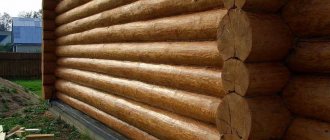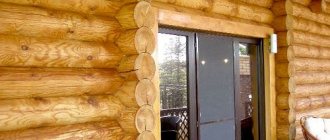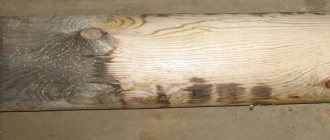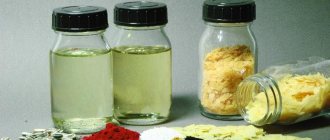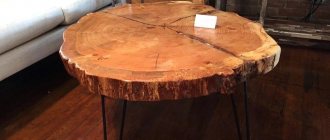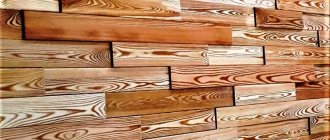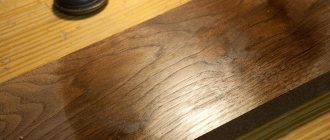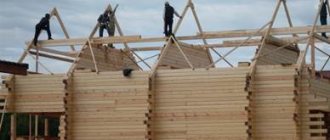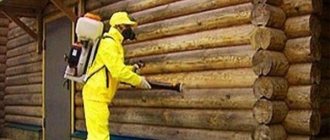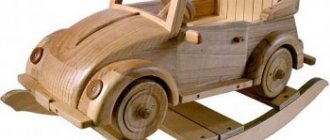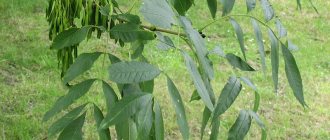Why you need to prevent wood from rotting
Wood processing is important for preserving products made from this material. Rotten wood is quickly subject to destruction: the house can fall apart, the fence can sag, the floor can collapse under your feet. Rotten wood not only loses its strength by more than 20 times, but its density by more than 2 times. It harms the health of people nearby. Molds that appear on wooden surfaces lead to respiratory diseases. This is why wood treatment is so important.
Mold may appear in wood if the material is exposed to the following influences:
- the surface of the tree in contact with the ground, as a rule, often gets wet and is subject to attack by wood beetles, microorganisms and other bacteria;
- a sharp drop in temperature - if the wood is not treated and tends to absorb moisture, then when it freezes, the absorbed liquid expands and creates cracks in the wood, which leads to stagnation of the liquid and the appearance of rot;
Due to a sharp drop in temperature, cracks appeared on the surface of the wood Source pxhere.com
- high air humidity (more than 80%);
- high humidity of the material itself;
- stagnant air.
How to tell if a tree is rotting:
- it becomes less dense and hard;
- small cracks appear;
- The color of the material changes and spots appear on it.
Protection of wood from rotting and moisture should be carried out in advance. Especially if the material will often get wet.
Mold began to cover the log house Source blogcamp.com.ua
Protecting wood with oil
Wooden materials have been treated with oil since ancient times. For this they used mainly linseed oil; it protected the wood and strengthened its structure. The treated wood material had good adhesion. You can apply the oil using a brush or spray. But it takes a very long time to dry, and wood processing must be done in at least 3 layers.
You can also use teak or tung wood oil to protect the wooden material; they can provide greater strength and absorb faster. It is better to treat wood with hot oils, because in this state they penetrate much deeper into the structure of the wood, thereby protecting it better. In general, it is difficult to call oil or drying oil a folk protective agent. After all, the production of paints and varnishes occurs with the addition of oils.
How can you prevent the negative effects of moisture on the material?
There are several options for preventing wood from being damaged by excessive moisture:
- Carrying out preventive measures.
- Use of folk remedies.
- Treating wood with antiseptics.
The latter are divided into the following categories:
- by place of application: for internal and external use;
- by composition: organic and inorganic;
- depending on what solvent is present in the composition: aqueous (such antiseptics, in turn, are divided into surface antiseptics and penetrating ones) or non-aqueous;
- by structure: powders that still need to be diluted, ready-made solutions and pastes;
- Oil antiseptics are isolated separately.
Let's look at all the options in more detail.
Drying boards naturally Source blog.flexyheat.ru
See also: Catalog of wooden house projects.
Carrying out preventive measures
Instead of fighting the rot that appears, it is easier to prevent its occurrence.
An effective way of prevention is to dry wooden materials in one of four ways:
- The longest way is to dry the board naturally. The material can be stored in a dry, well-ventilated area for up to a year.
- Drying wooden boards in a chamber using hot air is a faster and more effective way.
- The board is covered with liquid paraffin. After which it is fired for several hours in the oven. This method is called waxing.
- A small piece of wood can be dried by placing it in boiling linseed oil for a while.
Boiling wood in oil Source vilook.com
Wooden surfaces must be carefully inspected annually and, if areas susceptible to rotting are identified, they must be thoroughly treated.
Use of folk remedies
Time-tested folk remedies have their clear advantages:
- inexpensive cost;
- high efficiency;
- ease of use;
- hypoallergenic (for some products);
- environmental friendliness (for some products).
The following folk remedies are used to protect wood:
- Add 3 parts sunflower oil to 1 part propolis. The wooden surface is cleaned of dust and other contaminants and the mixture is applied.
Advantages: prevents the emergence of microorganisms that lead to rotting, protects the material from moisture.
Disadvantages: wood becomes flammable.
- Iron sulfate solution.
Advantages: high efficiency - the solution protects the material from fungal mold and bacteria; With thorough impregnation, additional measures to protect the wood from moisture and rot will not be required.
Disadvantages: long drying time (up to a month); The treated wood surface should not be exposed to direct sunlight until it is completely dry.
Iron sulfate Source vilzabota.ru
See also: Catalog of companies that specialize in the construction of wooden houses.
- Impregnation of wood with bitumen. Widely used for processing the lower logs of a log house.
Advantages: effective protection.
Disadvantages: not environmentally friendly.
- Impregnation of wood with machine oil.
Advantage: protects well from rot and mold.
Disadvantages: easily ignites.
- Finnish method. A solution for treating wood against rotting is prepared from water and flour mixed with salt, slaked lime and iron sulfate. The surface is treated with the heated mixture several times. After the first time, wait until the composition is absorbed and dries. And they impregnate the tree again.
Advantages: effective, time-tested method.
Disadvantages: it is necessary to apply the composition several times.
Impregnation prepared according to the Finnish method requires treating the wood several times Source woodstainruitei.blogspot.com
Protecting wood with copper sulfate
This method of wood processing is the most affordable and widespread. Copper sulfate prevents the formation of rotting of the material for a long time. Mixing with its juice, it prevents the action of moisture on wood, which is the main cause of its decay. This product changes the shade of the wooden material, which needs to be taken into account.
But there are also disadvantages to using copper sulfate; it is unsafe. When heated, it releases toxic substances. And when working with the composition, you need to use gloves to prevent it from coming into contact with the skin, as it irritates it.
Video description
Watch the video on how to protect a tree with baking soda:
The most popular antiseptics
Manufacturers of impregnations try to take into account all consumer requests. Depending on where the treated wood will be used, whether it comes into contact with metal parts, whether it will be exposed to weather conditions and other conditions, an antiseptic is selected. Among the most popular products on the Russian market are the following:
- "Senezh". It is difficult to wash out. This means that it can be used even where the tree will constantly come into contact with water. For example, in a bathhouse, sauna or for treating a fence, cellar, greenhouse. Protects against insects dangerous to wood. Can be used both indoors and outdoors. The manufacturer promises protection even in difficult conditions for 30 years
- "Bitsidol-100". Suitable even for tropical climates with high humidity. It is used to cover surfaces that are in the open air and those that are in direct contact with humans. Protects against wood-boring insects. Effective against mold and rot. Can change the color of a wooden surface to green.
A tree beetle spoils a tree Source pest-destroy.ru
Reasons for appearance
In natural conditions, trees, thanks to their immunity, successfully protect themselves from the active spread of biopollutants. Subsequently, the natural resistance of the wood declines, so it needs to be treated.
Additional infection can occur due to improper storage and operation of structures. The following factors contribute to the appearance of mold on wood:
- high humidity;
- temperature changes over a wide range of values;
- ineffective ventilation;
- freezing of the material;
- poor waterproofing of the building;
- high groundwater level.
Fungi can be brought into the room on shoes or clothes, so when entering, you should follow basic sanitary rules. Often the source of microbes is drywall, in which they multiply easily and quickly. In wet places, you need to install only special plasterboard sheets that are suitable for use in such conditions.
If the negative effects of the environment are completely eliminated or at least significantly reduced, fungal infections of wood can be completely avoided, freeing yourself from the need for treatment.
Recommendations for wood processing
In order for the result after processing wood to be as expected, it is necessary to strictly follow the instructions and follow general recommendations:
- First of all, you need to think about human protection. The treatment agent should not come into contact with the skin or mucous membranes of the eyes. Inhaling fumes from used antiseptics can also be very dangerous. Therefore, it is better to wear a special mask over your eyes. Protect your mouth and nose with a respirator. Wear long rubber gloves on your hands.
- In order for the product to have maximum effect, the wooden surface must be prepared. The wood is cleaned of paint, varnish, dirt and dust.
- To apply impregnation, use a roller, brush, soft sponge or rag. If the treatment surface is very large, you can use a spray bottle.
- It is best to process wood in dry and warm conditions. The material itself must also be dry.
- Excessive antiseptic consumption does not mean more effective protection. It's better to follow the instructions.
First of all, you need to take care of safety Source chameleon40.ru
Protecting wood with birch tar
To provide a high degree of protection to wooden material from insects and rot, you can treat it with birch tar or spruce resin. These compounds have a strong odor, they are soiled and sticky, which makes working with them difficult. Wood treated with tar cannot be subsequently painted, sanded or subjected to other mechanical impacts. In addition, wood with this resinous composition applied to it is easily flammable. Therefore, treated wood can only be used in underground parts of the building structure.
Protecting wood with used motor oil
This is the most common and inexpensive, one might even say free, method of providing protection to wooden material. It is used mainly in rural areas for processing non-residential wooden structures. Waste oil consists of 90% mineral oil, which is a good water-repellent and antiseptic agent. It also contains a lot of soot, which protects the wood from the destructive effects of ultraviolet rays. And a small part of acid salts that eliminate any type of fungus existing in the wooden material.
The working material is applied in a heated state to the surface of the material several times. Particular attention is paid to the ends and crevices of the wood. If the treated log is dug into the ground, then for efficiency, a little oil is added to the hole itself, and after the post is buried, the mining is poured around it. The disadvantage of using waste is its soiling and unpleasant dark tint.
Protecting wood with tar
Tar or bitumen is still used to prevent rotting of wooden materials. This method of protection is common for wood of underground structures or for the lower crowns of a log house, which experience adverse effects from the environment to a greater extent.
Before using tar or bitumen, they should be heated and mixed in diesel fuel. Then coat wooden materials with the resulting composition. This method is an effective protective method, but not entirely environmentally friendly. Although now they produce mastics and impregnations with the addition of bitumen.
